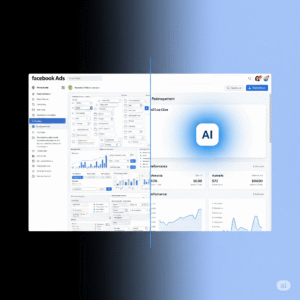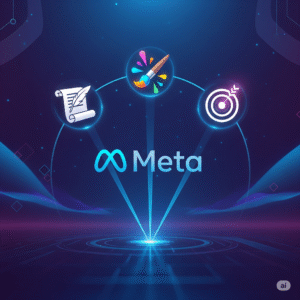For years, we performance marketers wore our complex ad accounts like a badge of honor. Dozens of campaigns, hundreds of ad sets, intricate Lookalike stacks, and hyper-specific interest layers—it was a testament to our diligence and expertise. We believed that the more levers we pulled, the better our results would be. But what if I told you that in 2025, this complexity is the very thing holding you back? What if the most sophisticated strategy is also the simplest? It’s time to talk about the truth of Meta Ads broad targeting, a strategy that feels wrong but delivers results that are undeniably right.
This isn’t a beginner’s hack. This is the new pro move. It’s about having the courage to unlearn years of conventional wisdom and place your faith in Meta’s multi-billion dollar AI. It’s about moving from a “hands-on” approach to a “hands-off,” strategic one. After managing massive budgets and seeing the data firsthand, I’m convinced that trusting the algorithm isn’t lazy—it’s lethal. This guide will show you why the future of Facebook advertising is minimalist and how you can leverage Meta Ads broad targeting for explosive growth.
The Great Unlearning: Deconstructing the Myth of Hyper-Targeting
The first step toward embracing this new paradigm is understanding what it is and why the old ways are becoming less effective. It requires us to challenge some of our most deeply held beliefs about digital advertising.
So, What is Meta Ads Broad Targeting, Really?
Meta Ads broad targeting is the practice of setting up an ad set with only the most basic demographic constraints—typically just location, age, and sometimes gender—and leaving all detailed targeting (interests, behaviors, lookalikes) completely blank. Yes, you read that right. It’s often referred to as Facebook ads no targeting. To a traditional marketer, this sounds like setting your ad budget on fire. You’re seemingly showing your ads to “everyone.”
But that’s where the misconception lies. You aren’t showing your ads to everyone. You are simply giving Meta’s AI the maximum possible room to operate. You’re removing the handcuffs that your own assumptions placed on the campaign and allowing the algorithm to use its vast intelligence to find your ideal customer, wherever they may be. It’s the ultimate act of trusting the algorithm to do what it was designed to do.
Why Your Obsession with Granular Targeting is Hurting You
For years, we were taught that narrowing our audience was the key to efficiency. But as Meta’s AI has grown exponentially more powerful, this approach now creates more problems than it solves. Hyper-targeting leads to smaller audience pools, which means higher CPMs (cost to reach 1,000 people), faster ad fatigue, and intense competition for the same small slice of users.
More importantly, your assumptions about who your customer is are often wrong or, at the very least, incomplete. By targeting only people who like “Yoga” and “Lululemon,” you might be completely missing out on a huge group of customers who are buying your athletic wear for comfortable work-from-home attire and have never once set foot in a yoga studio. A rigid, manual setup actively prevents the discovery of these new, profitable customer segments. This is where a Meta Ads broad targeting strategy doesn’t just win; it dominates.
The Power of the Pixel: Why Meta Ads Broad Targeting Works in 2025
The reason this “no targeting” strategy is so effective today comes down to one thing: the immense power of your Meta Pixel and Conversions API data.
It’s Not “No Targeting,” It’s AI-Powered Targeting
This is the most critical concept to grasp. Meta Ads broad targeting is not the absence of targeting; it’s the pinnacle of AI-powered targeting. Every time a user converts on your website, your Pixel sends thousands of data points back to Meta. The AI analyzes the characteristics of that converting user—not just their stated interests, but their Browse patterns, the content they engage with, their purchasing behavior across the platform, and a thousand other signals.
When you run a broad campaign optimized for conversions, you are telling the AI: “Here is what my ideal customer looks like in action. Go find more people who behave just like this, regardless of what they’ve listed as an ‘interest’.” The AI then scours the entire user base you’ve given it (e.g., all men aged 25-54 in the United States) to find lookalikes of your converters in real-time. It’s a dynamic, self-optimizing Lookalike audience on a massive scale.
The Role of Data Maturity in Successful Meta Ads Broad Targeting
It’s important to note that this strategy thrives on data. An ad account with a mature Pixel that has recorded hundreds or thousands of conversions has a rich dataset for the AI to learn from. This is why Meta Ads broad targeting works so phenomenally well for established businesses looking to scale.
If your ad account is brand new with zero conversion history, the AI has less to work with. In such cases, you might start with a slightly more targeted approach (like using Advantage+ Audience with suggestions) for a few weeks to “season” the pixel. Once you have a steady stream of 50-100 conversions, you can confidently unleash the power of broad.
The Minimalist Ad Account Setup: Case Studies in Profitability
The theory is sound, but the proof is in the P&L statement. A minimalist ad account setup not only simplifies your life but can drastically improve your bottom line.
Real-World Proof of Meta Ads Broad Targeting Success
Case Study 1: “GlowUp Cosmetics” – Scaling E-commerce
This popular e-commerce beauty brand was stuck. They were managing over 20 ad sets, targeting dozens of Lookalikes and interest groups. Their account was a nightmare to manage, and their blended CPA was steadily rising.
The Solution: We paused all their complex prospecting campaigns and consolidated the entire budget into a single Advantage+ Campaign with one ad set using Meta Ads broad targeting. We set the targeting to “Women, 25-65, United States” and let it run. The creative was designed to be highly self-selecting, showcasing their unique value proposition. The result? Within two weeks, their account-wide CPA dropped by 25%. More incredibly, the AI began finding huge pockets of customers in the 55+ age bracket, a demographic they had previously ignored. The minimalist ad account setup didn’t just save time; it unlocked a new level of scale.
Case Study 2: “SyncFlow” – B2B Lead Generation
A B2B SaaS company specializing in workflow automation wanted to generate demo requests. They believed Meta was only for B2C and that they needed the precise job-title targeting of LinkedIn.
The Solution: We convinced them to test a Meta Ads broad targeting campaign. The creative did all the work. The headline was direct: “Are you wasting 10+ hours a week on manual data entry?” The video ad showed the exact pain point their software solved. The targeting was simply “Men and Women, 30-55, Canada & UK.” The AI, guided by the “Schedule Demo” conversion event, sifted through the broad audience and successfully found project managers, operations directors, and small business owners. The cost per demo was 60% lower than on LinkedIn, proving that with the right message, Meta Ads broad targeting can deliver high-quality B2B leads.
Your Action Plan: How to Implement Meta Ads Broad Targeting Safely
Ready to take the leap? Here’s a simple workflow for trusting the algorithm without risking your entire budget.
- Audit Your Data Foundation: Before you start, ensure your Meta Pixel and Conversions API are flawlessly tracking your primary conversion event (e.g., Purchase, Lead). Garbage in, garbage out. Accurate data is non-negotiable.
- Start with a Controlled Test: Don’t delete your existing campaigns. Create a new Advantage+ Campaign and allocate 20-30% of your prospecting budget to it. Create a single ad set inside with your broad targeting parameters.
- Craft Self-Selecting Creative: This is now your #1 job. Your ad must act as a filter. It should speak so directly to your ideal customer’s pain points and desires that anyone who isn’t a good fit scrolls right past.
- Set Your Exclusions: This is crucial. Always exclude your existing customer lists and recent purchasers (e.g., last 90 days) to ensure your broad campaign is focused purely on new customer acquisition.
- BE PATIENT: This is the hardest part. You must let the campaign run, untouched, for at least 7-14 days to exit the learning phase. Resist the urge to tinker. The AI needs time and data to find its groove.
The Strategic Shift & The Tools You’ll Need
This new approach fundamentally changes your role. You’re no longer an ad set architect; you’re a business strategist and creative director. This shift requires a different set of tools.
- For Creative Velocity (Generative AI): Use ChatGPT or Gemini to brainstorm dozens of ad angles and write copy variations. As OpenAI states in its charter, AI should be used to amplify human creativity, and this is a perfect example.
- For Business Intelligence (BI Tools): Use Tableau or Power BI to analyze performance. A minimalist setup allows you to focus on bigger questions: “How is my blended ROAS changing?” “What is the LTV of customers acquired through broad targeting?”
- For Lead Management (CRM): A solid CRM like HubSpot is essential for tracking the journey of leads from a broad campaign. This helps you prove that the leads are high-quality and convert into actual revenue, justifying the strategy. HubSpot’s resources on CRM are a great place to learn more.
- Advantage+ Audience vs Lookalike
The Final Word on Meta Ads Broad Targeting
Let’s be clear: Meta Ads broad targeting isn’t a magic bullet, but it is the most powerful and scalable strategy available to most advertisers on the platform today. It requires a shift in mindset—from control to trust, from complexity to simplicity, and from audience curation to creative excellence.
Stop fighting the algorithm. Stop building convoluted campaigns that limit your own success. Have the courage to simplify, feed the machine great creative, and let Meta’s AI do what you can’t: analyze trillions of data points in real-time to find your next customer. That’s not just a new tactic; it’s the future of advertising.
Meta Advantage+: Facebook Ads Easy Mode
Advantage+ Audience for Unbeatable Prospecting Results in 2025



